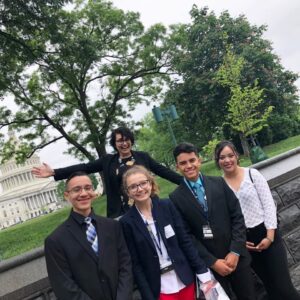On my second day as an AmeriCorps VISTA (Volunteers in Service to America) with Arizona SciTech, I accompanied my new supervisor to an organization offering youth courses in robotics, 3D modelling, game development, and virtual reality – all things which I, as a biologist, imagined as only existing in the futuristic lab-caves of Silicon Valley.
The existence of these technologies in an inconspicuous office building was eye-opening to me, but what really blew me away was my first experience with virtual reality. I was able to fly through neurons firing in a brain, travel with blood cells into a ventricle of a heart, and pick apart a human skeleton; even more amazing, the person who created the program was just 13 years old. She greeted us at her desk wearing a colorful sundress and humbly shared her work with us in between talking with me about the newest season of Doctor Who.
I was thrilled to learn about possibilities for the future of learning and technology, and incredibly inspired by this student programmer who was kicking so many STEM

stereotypes to the curb. This not only opened my eyes to the future of technology and the possibilities for its integration into education, but it also made me realize something more profound. When people in education talk about the fact that “children are the future,” I always took it to mean that students are being equipped to jump into the workforce when they grow up. I now understand this phrase differently – our youth are the future because they are creating it now.
Everything our students are learning, particularly in STEM fields, are the materials they are using to craft what our world is going to look like in 10, 20, even 50 years from now. They have already begun, with kids inventing ways to detect disease and programming immersive learning experiences for the students who follow them. This, I have come to realize, is why the emphasis on STEM is so critical – our students are already building the future, and we, as STEM Ecosystems, need to make sure they have all the tools that they need.
On this front, the project I have spent nearly the last two years working on as an AmeriCorps VISTA is changing the game. When I joined the Chief Science Officer (CSO) project in Fall of 2016, Arizona had 220 6th-12th grade students who were acting as champions for STEM opportunities at their schools and representing their peers in critical community conversations surrounding STEM education and workforce. In addition to working with those students and their schools, I joined a team of changemakers across the country – and the world – bringing the CSO program to their regions.
My day-to-day support of the program is constantly evolving; a typical day can involve providing resources to students and teachers for projects at their schools, responding to organizations seeking CSOs participation in their events, planning our own events for CSOs, meeting with potential or ongoing community partners, or attending community functions to network. More recently, I have worked with partners in Oregon, Michigan, Georgia, and DC in order to plan CSO involvement in two national conferences, and have supported CSO program teams internationally in starting up the CSO program in their regions.
At the beginning of the 2017-2018 school year, our Arizona cabinet of now 320 CSOs was joined by cabinets in Oregon (developed and run by my dear friend and fellow Ecosystem AmeriCorps VISTA member, Allison Sweeney), Michigan, the Midwest, and Kuwait. Alongside facilitating the international growth of these cabinets of young STEM leaders, I have also been the primary organizer for bringing CSO students to three national conferences in the last year. In Arizona and at these conferences, I am beginning to see more and more community leaders welcoming youth voices into their conversations surrounding STEM education – and I couldn’t be more proud of our young leaders taking on the STEM challenges of today and of the future.
